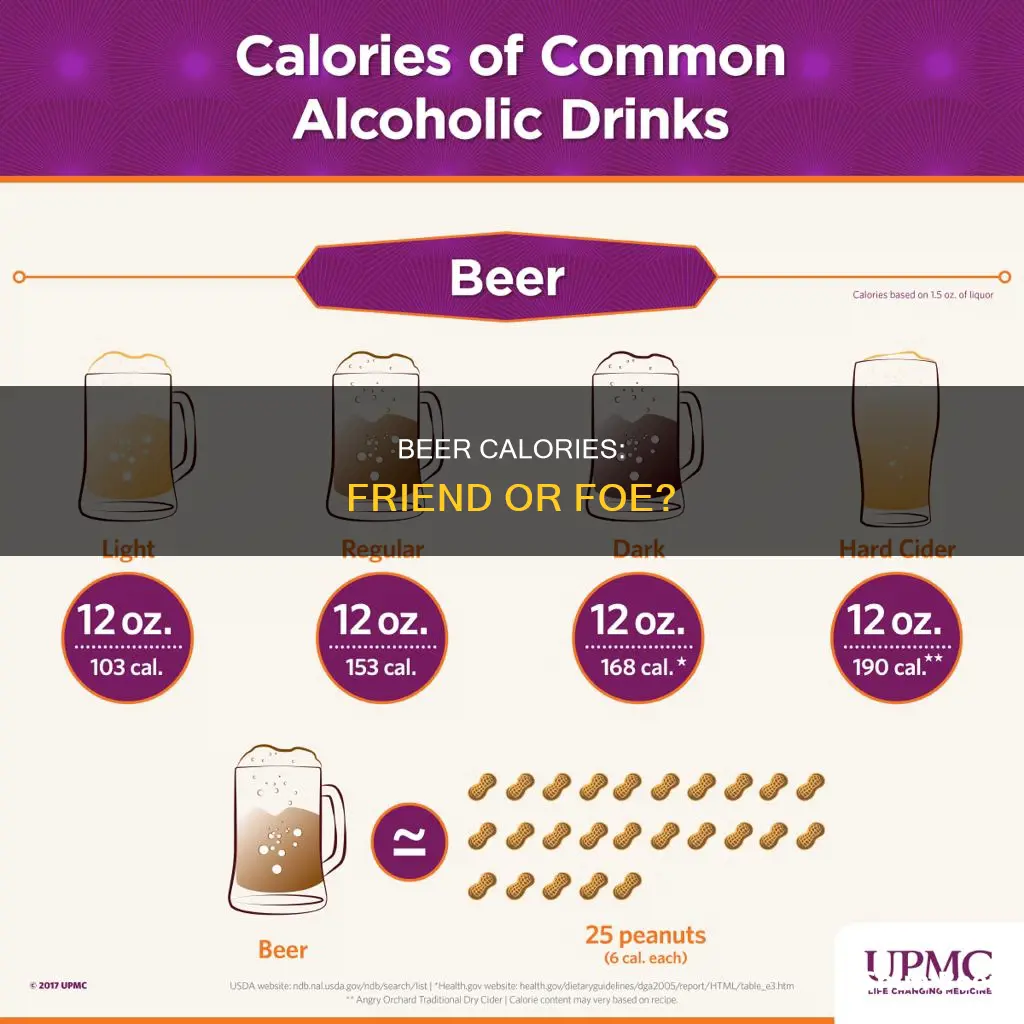
Beer is a popular alcoholic drink made from fermented grains. It is often associated with weight gain, particularly around the belly, and is believed to have a high-calorie content. However, the calorie count in beer varies depending on the type and brand. A standard 12-ounce serving of popular beers in the United States ranges from 95 to 150 calories. The calorie content is influenced by factors such as alcohol percentage, with beers containing higher alcohol levels generally having more calories.
What You'll Learn

Beer contains calories from carbs and alcohol
Beer is made from fermented grains, such as barley, wheat, or rye, and flavoured with hops. The calories in beer come mainly from carbs and alcohol. The number of calories in beer depends on its strength—the more alcohol it contains, the more calories it contains. Beer is high in carbs and alcohol but low in other nutrients.
Craft, seasonal, and high-alcohol beers tend to have more calories than lighter beers. Alcohol-free options will usually contain fewer calories. The calorie content of beer is higher than that of wine or spirits such as whiskey. Beer contains more calories per gram than carbs and protein but fewer than fat.
The American Heart Association recommends that men consume no more than two alcoholic drinks per day and women no more than one. Drinking fewer calories can be achieved by opting for light beers, drinking water between alcoholic drinks, sipping drinks slowly, and avoiding drinking on an empty stomach or late at night.
In addition to calories, beer also contains small amounts of micronutrients, including sodium, potassium, and magnesium. However, the amount of these nutrients is not significant enough to make beer a good source of them.
Natural Lite Beer: Calorie Count and Health Benefits
You may want to see also

Calorie content depends on alcohol content
The calorie content of beer depends on its alcohol content. Alcohol contains seven calories per gram, which is higher than carbs and protein (four calories per gram) but lower than fat (nine calories per gram). Therefore, beers with a higher alcohol content tend to have more calories. For example, a standard 12-ounce (355-millilitre) serving of regular beer with 4% alcohol content has around 153 calories.
Craft, seasonal, and high-alcohol beers tend to have more calories than lighter beers. For instance, Budweiser, a heavier beer than Bud Light, has 145 calories compared to Bud Light's 110 calories. Similarly, Corona Extra, a darker brew, has 148 calories, making it one of the heaviest beers on a list of America's best-selling beers.
On the other hand, non-alcoholic beers typically have fewer calories. For example, Coors Edge (0.5% ABV) has 45 calories, while Heineken 0.0 (0.0% ABV) has 69 calories.
Light beers also tend to have fewer calories than regular beers. For example, a 12-ounce serving of light beer typically has around 100 calories, while a regular beer of the same size has around 150 calories.
In summary, the calorie content of beer varies depending on its alcohol content, with higher-alcohol beers tending to have more calories. However, other factors, such as the type of beer (e.g., craft, seasonal, light) and the presence of non-alcoholic or low-alcoholic versions, can also affect the calorie content.
Heineken Zero Beer: Calorie-Free Refreshment
You may want to see also

Alcohol content ranges from 0.5% to 40%
The alcohol content of beer varies depending on the type of beer and the brewing process. Typically, the alcohol content of beer falls between 4% and 6% ABV (alcohol by volume). However, it can range from very weak to exceptionally strong, with the lowest being 0.5% ABV and the highest reaching 40% ABV.
ABV is a standard measure of the volume of alcohol in a given volume of an alcoholic beverage. It is defined as the number of millilitres of pure ethanol present in 100ml of solution at 20°C. For context, a standard drink in the United States contains approximately 14 grams of pure alcohol, which is typically found in 12 ounces (355ml) of regular beer, 5 ounces (150ml) of wine, or 1.5 ounces (45ml) of spirits.
The calorie content of beer is influenced by its alcohol and carbohydrate content. Generally, beers with higher alcohol content have more calories. For example, a standard 12-ounce (355ml) beer contains around 153 calories.
Craft beers, seasonal beers, and beers with high alcohol content tend to have more calories than lighter beers. Alcohol-free beers usually contain fewer calories, making them a better option for those watching their calorie intake.
Beer Calories: Little Brown Note's Secrets Unveiled
You may want to see also

Light beers have fewer calories
Beer is often associated with an increase in body fat, particularly around the belly, or the "beer belly". However, light beers have fewer calories than regular beers, and can be a better option if you're deciding between the two.
A standard 12-ounce (355 ml) beer contains around 153 calories, but light beers typically have fewer calories. For example, Bud Light has 110 calories, Busch Light has 95 calories, and Miller Lite has 96 calories.
It's important to note that the definition of "light beer" can vary among brands. Sometimes it means the beer contains less alcohol, sometimes it means fewer calories, and sometimes it means both.
When choosing a beer, it's essential to consider your health goals and needs. If you're watching your calorie intake, a light beer with fewer calories might be a better option. However, it's worth noting that drinking excessive amounts of light beer can still contribute to weight gain and other health issues, such as liver disease and increased risk of certain cancers.
Additionally, it's worth mentioning that the health effects of drinking beer are mixed. While light to moderate beer intake has been linked to potential benefits, such as improved blood sugar control and reduced dementia risk, heavy and binge drinking have negative consequences, including an increased risk of weight gain, depression, and early death.
In conclusion, light beers typically have fewer calories than their regular counterparts, but it's important to consume them in moderation and as part of a balanced lifestyle to maintain overall health.
Pelican IPA Beer: Calorie Count and Nutrition Facts
You may want to see also

Beer is not a good source of nutrients
Beer is often viewed as empty calories, and while it does contain some vitamins and minerals, it is not a good source of nutrients. Beer is made from fermented grain, and the calories it contains are mainly from carbs and alcohol.
Beer contains small amounts of sodium, potassium, calcium, thiamine, iron, and zinc. It also has some B vitamins, which come from the cereal grains and yeast used in the brewing process. However, it is not a good source of these nutrients compared to whole foods like fruits and vegetables. You would need to drink large amounts of beer to satisfy your daily nutrient requirements.
For example, a standard 12-ounce (355 ml) beer contains around 153 calories. Consuming multiple drinks can contribute to weight gain. Beer is also associated with an increase in body fat, particularly around the belly, commonly known as a "beer belly."
Craft, seasonal, and high-alcohol beers tend to have more calories than lighter beers. Alcohol-free options usually contain fewer calories. If you are concerned about your calorie intake, it is best to stick to low-calorie options and drink in moderation.
Light Beer Calories: Modelo's Nutritional Breakdown
You may want to see also
Frequently asked questions
Beer is not necessarily a bad calorie, but it is important to consume it in moderation as part of a healthy diet. Beer is often viewed as empty calories, but it does contain some vitamins and minerals, such as B vitamins, magnesium, and potassium.
The calorie content of beer varies depending on the type and brand. A standard 12-ounce serving of popular beers in the United States ranges from around 95 to 150 calories. A pint of beer typically contains around 153 calories.
Yes, there are many low-calorie beer options available, including light beers and non-alcoholic beers. Some examples of low-calorie beers include Budweiser Select, Molson Ultra, and Coors Light.
Beer can contribute to weight gain, including belly fat, if consumed in excess. The more you drink, the higher your risk of weight gain. However, moderate drinking of one beer per day is not typically linked to significant weight gain.
Beer tends to have a higher number of calories compared to wine or spirits. For example, a standard serving of wine (5 ounces) typically contains around 125 calories, while a shot of liquor (1.5 ounces) contains around 97 calories.







